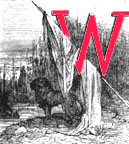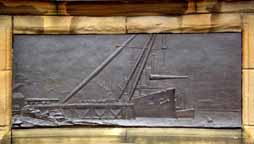 illiam Armstrong was one of those Victorians whose great talents were matched by great energy. He was a Northumbrian inventor, arms manufacturer, and shipping magnate, who also designed and built swing-bridges such as the one over the River Tyne at Newcastle. Amongst his other very active interests were politics, education, archaeology and landscaping. He was important too as a benefactor, since he made large donations and bequests to Newcastle’s Royal Victoria Infirmary, natural history museum, and so on.
illiam Armstrong was one of those Victorians whose great talents were matched by great energy. He was a Northumbrian inventor, arms manufacturer, and shipping magnate, who also designed and built swing-bridges such as the one over the River Tyne at Newcastle. Amongst his other very active interests were politics, education, archaeology and landscaping. He was important too as a benefactor, since he made large donations and bequests to Newcastle’s Royal Victoria Infirmary, natural history museum, and so on.
Born in the Newcastle area to a Tyneside corn-merchant and politician, Armstrong was locally educated before continuing his legal training in London. Although he duly qualified as a solicitor and became a partner in a Newcastle firm in 1835, he had already developed a fascination with engineering, and now became particularly interested in hydraulics, although he first made his name in the field of electrostatic generation. In 1846 he became a fellow of the Royal Society. He then left the law to focus on the industrial application of his ideas, founding the Elswick Engine-Works in Newcastle in 1847. The firm manufactured not only the hydraulically-powered cranes which he had invented in 1845, but also warehouse lifts and swing-bridges, and the hydraulic accumulators which he invented in 1850-51 for transmitting hydraulic power.


Left: Plaque from the Armstrong Memorial in Newcastle by Hamo Thornycroft.
Right: Iron and Coal by William Bell Scott.
[Click on the thumbnail for a larger image.]
With the Crimean War and a request from the government in 1854 to produce submarine mines, the firm next branched out into armaments. Armstrong designed his innovative gun with its ’barrel ’ built up of successive coils of wrought iron" (McGovern 66), superintended the royal gun factory at Woolwich from 1859 to1863, and established an ordnance factory next to his Tyneside engine works. Hence the armaments shown in William Bell Scott’s painting Iron and Coal at the nearby Northumberland estate of Wallington, to which the pacifist owner of the estate, Sir Walter Calverley Trevelyan, objected even in those days (Batchelor 143). According to Marshall J. Bastable, Armstrong himself had ’entered the armaments business reluctantly," looking upon improved artillery as an ’interesting engineering problem, not as a new business adventure" (20). Naturally, though, he promoted his own inventions, and they certainly brought him both money and recognition — he was knighted in 1859, when he became superintendent at Woolwich. Again, although he needed some persuasion to sell to foreign powers (Bastable 100), his subsequent role in supplying arms to both sides in the American Civil War, as well as to many other countries, put the arms industry on a new commercial footing. After ship-building was commenced in 1882, he sold his Tyneside-built warships to navies all over the world. In particular, he filled many orders from Japan, for which he was honoured in 1895 as a Sacred Treasure of the Rising Sun.


Left: William George Armstrong, Baron Armstrong of Cragside by Hamo Thornycroft.
Left: Baron Armstrong's home, Cragside designed in part by R. Norman Shaw. [Click on the thumbnails for larger images.]
In later years Armstrong and his wife Margaret lived at Cragside, near Rothbury, Northumberland. This had originally been built in 1864 as a simple two-storey sporting lodge by an unknown builder-architect. However, Armstrong made it his main residence after the Tyneside strike of 1871 took the shine off his reputation as an enlightened employer. The house was rebuilt as a full-scale country estate during the periods 1870-77 and 1883-85 by R. Norman Shaw, and during the remainder of his life Armstrong devoted himself to perfecting it inside and out. A Japanese room, surprising to come upon in this remote Northumbrian context, must have been a later project. However, Armstrong had not withdrawn from public life. On the contrary, as a philanthropist with a special interest in education, he was instrumental in the evolution of the University of Newcastle, and after he became a peer in 1887 (the first engineer to be thus honoured) he took a keen interest in the Irish Question at the House of Lords. As President of the British Association in 1883, Armstrong had been prescient enough to foresee future developments like solar power; but he was also intrigued by the past: a trip to Egypt in 1872 had triggered an interest in archaeology, and in 1893 he bought and did much to restore Bamburgh Castle on the Northumbrian coast, a fortification which has a history going back to about 420 AD. The castle is still in the hands of the Armstrong family today, and houses the Armstrong Museum.
Although the Armstrongs themselves were childless, Lord Armstrong’s name was continued for many years by what was eventually the Vickers-Armstrong engineering conglomerate, and there is still an Armstrong Industrial Estate in Newcastle. Yet he is seldom mentioned in general studies of his period. For example, Sally Mitchell’s huge Encyclopedia of Victorian Britain (Garland, 1988), and Roger Ellis’s compendious Who’s Who in Victorian Britain (Shepheard-Walwyn,1997), both ignore him. Perhaps this is because he had his greatest or at least most immediate impact in the north, where he is remembered primarily as the founder of the first ’of the great firms which have done so much to further the fame and fortune of Tyneside" (Hearnshaw 118). As a philanthropist and politician as well, Armstrong’s concerns tended to be local (the Irish problem would have exercised him because of the large number of Irish workers in Newcastle). Then there are the larger issues. Sir Walter Trevelyan was not the only one to deplore the arms industry or its results. For example, in the very year in which Armstrong was working on his first rifled gun, the radical MP John Bright (another Northerner) was pleading impotently for ’the sword to [be returned to] the scabbard" so that ’torrents of blood" would cease to flow in the Crimea (qtd. in MacArthur 306). The long-term results of Armstrong’s technological and commercial breakthroughs were to be even more contentious than the short-term ones.
However one feels about these issues, Lord Armstrong should not be forgotten. He was a major player in Victorian industry, might and empire. As Stafford M. Linsley writes, ’He bestrode much of the nineteenth century as a singular figure in science, industrial development, philanthropy and liberalism." Although his name is most likely to crop up in connection with munitions, he was by all accounts mild-mannered in himself — if somewhat reserved. Linsley adds pleasantly, ’while he greatly profited from his life financially, he retained a love of the country and a personal simplicity."
Sources
Bastable, Marshall J. Arms and the State: Sir William Armstrong and the Remaking of British Naval Power, 1845-1914. London: Ashgate, 2004.
Batchelor, John. Lady Trevelyan and the Pre-Raphaelite Brotherhood. London: Chatto & Windus, 2006.
"Cragside." National Trust Handbook for Members and Visitors, 2007.
Hearnshaw, F.J.C. Newcastle-On-Tyne (in The Story of English Towns series). London: Sheldon Press, 1924. (Note: Hearnshaw, who wrote this book while Professor of History at King’s College, London, was previously a Professor at the Armstrong College, Newcastle, which in 1963 amalgamated with Newcastle’s College of Medicine to produce the University of Newcastle.)
Linsley, Stafford M. ’Armstrong, William George, Baron Armstrong." Oxford Dictionary of National Biography. Online ed. Viewed 14 July 2007.
MacArthur, Brian, ed. The Penguin Book of Historic Speeches. Harmondsworth: Penguin, 1996.
McGovern, Una. Chambers Biographical Dictionary. Edinburgh: Chambers Harrap, 7th ed. 2002.
Last modified 22 December 2005